Topics List
May 23, 2016 Updated
A movie of the Venus’ night-side produced by IR2
|
This movie is produced from the IR2 2.26-μm images, acquired on 29 March 2016 at a distance of 0.36 million km. Original 4 images were acquired with 4-hour intervals from 16:03 JST (07:03 UT). In 4 hours, the super-rotating clouds move by ~10 degrees. Such images are numerically derotated to produce intermediate images so that the resultant motion becomes smoother. Deformation, appearance and disapperance of clouds are obvious in this movie. As the mission enters the “nominal” observing phase, we plan to shorten the intervals to 2 hours or even shorter so the high-definition movies will definitely help understanding of the Venus atmosphere. |
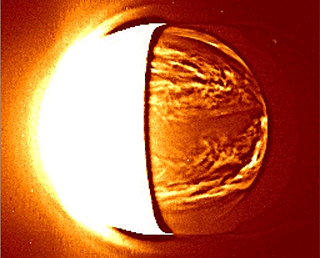 |
|---|
Apr. 28, 2016 Updated
AKATSUKI onboard instruments to move to regular operation
|
JAXA decided to shift the operation mode of the five onboard instruments of AKATSUKI to the regular operation mode, namely 1μm camera (IR1), 2μm camera (IR2), Longwave IR camera (LIR), Ultraviolet image (UVI), and Ultra-stable Oscillator (USO). [Message from Project Manager Masato Nakamura] Image: Night side of Venus taken by the IR2. |
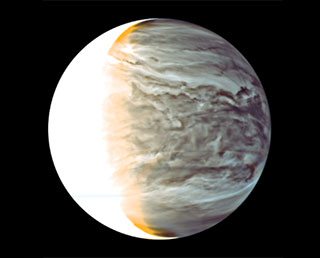 |
|---|
Apr. 1, 2016 Updated
AKATSUKI regular observation to begin in mid April
|
AKATSUKI has been performing test observations by turning on its onboard observation instruments one by one. The instruments are starting up normally, and we have already conducted successful observations that are equivalent to a “minimum success” (*), thus we will move to regular operations in mid April. * Minimum success: The minimum goal for achieving a mission. For AKATSUKI, the minimum success is to capture Venus’s all-globe cloud structure by continuously acquiring image data (for every few hours) using some of its onboard cameras from Venus orbit. Image: Test observation results by the Longwave IR camera (LIR) The image shows bow-shape clouds running from the Southern hemisphere to the Northern one of Venus. This is the first time to learn such a phenomenon. |
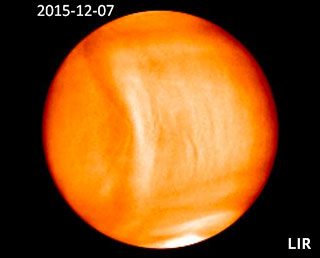 |
|---|
Dec. 9, 2015 Updated
AKATSUKI successfully inserted into Venus’ orbit
|
As a result of measuring and calculating the AKATSUKI’s orbit after its thrust ejection on Dec. 7, JAXA found that the AKATSUKI was inserted into the Venus orbit. Image: Venus taken by UVI on Dec. 7 (JST). |
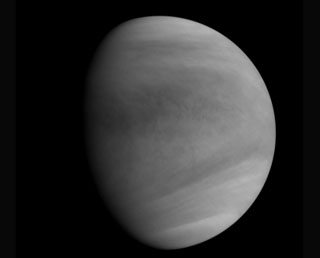 |
|---|
Dec. 7, 2015 Updated
AKATSUKI attitude control engine thrust operation performed as scheduled
|
JAXA performed the attitude control engine thrust operation of the Venus Climate Orbiter “AKATSUKI” for its Venus orbit insertion from 8:51 a.m. on December 7 (Japan Standard Time). |
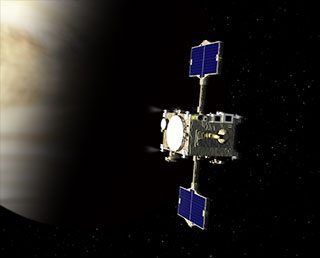 |
|---|
Dec. 7, 2015 Updated
Test image acquisition by AKATSUKI onboard cameras (on Dec. 1, 2015)
|
The AKATSUKI had been maintaining a safe posture by facing its mounting surface of the high-gain antenna toward the sun as that surface is relatively strong against heat. In that posture, the onboard cameras, which were stowed in the main body of the orbiter, were not able to change their view direction. |
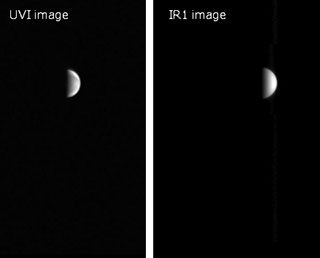 |
|---|
Nov. 9, 2015 Updated
AKATSUKI: Second attempt to enter Venus orbit
|
The Venus Climate Orbiter AKATSUKI will try to enter the orbit of Venus on Dec. 7 (Mon.) after five years of operation. We are welcoming support messages. |
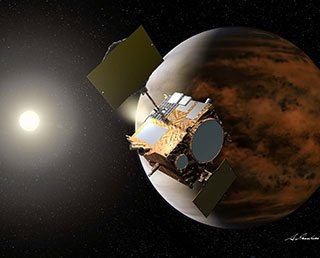 |
|---|
Aug. 31, 2015 Updated
AKATSUKI passed the perihelion
|
The Venus Climate Orbiter “AKATSUKI” flew at the closest point to the Sun, the perihelion, on its orbit at around 2:00 a.m. on Aug. 30, 2015. It is the ninth time of passing the perihelion since its launch in 2010. The AKATSUKI is still in a difficult state regarding the thermal environment, even after it flew away from the perihelion. |
 |
|---|
Aug. 5, 2015 Updated
AKATSUKI: Orbit successfully controlled
|
JAXA performed an orbit control maneuver for the Venus Climate Orbiter “AKATSUKI” in late July in preparation for its re-injection into the Venus orbit scheduled for Dec. 7, 2015. According to the analysis of telemetry data acquired up to Aug. 2, the orbit control and correction was successfully conducted as scheduled by 5:30 p.m. on August 4. (All dates and time are Japan Standard Time.) |
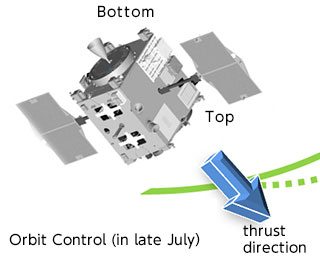 |
|---|
Jul. 9, 2015 Updated
AKATSUKI to perform fourth orbit control to Venus
|
The AKATSUKI will perform an orbit control for the fourth time (DV4: Delta Velocity 4) from July 17, targeting to be injected into the Venus orbit again in December 2015. The control will be divided into three performances. |
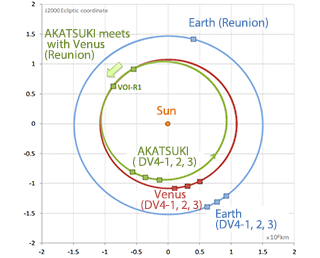 |
|---|
Feb. 6, 2015 Updated
AKATSUKI to be re-injected into Venus orbit on Dec. 7
|
After failing to be injected into the Venus orbit in Dec. 2010, JAXA has been carefully considering another injection attempt opportunity for the Venus Climate Orbiter “AKATSUK” to the Venus orbit when the orbiter meets Venus in the winter of 2015. As a result of detailed study, JAXA decided to inject the AKATSUKI into the orbit on December 7 (Mon.), 2015. |
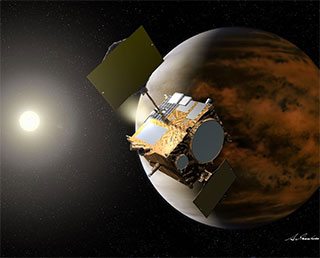 |
|---|
Jan. 9, 2015 Updated
AKATSUKI heading to Venus again
|
The Venus Climate Orbiter “AKATUSKI” has been flying on an orbit in which it could meet Venus again in 2015 since it carried out orbit control maneuvers three times in 2011 after its failure to be injected into the target orbit due to damage to its main engine in Dec. 2010. |
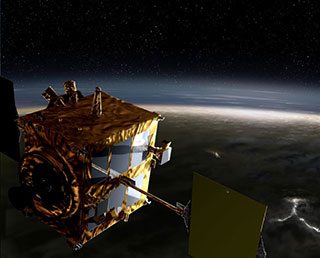 |
|---|
Jan. 31, 2012 Updated
AKATSUKI current status and future operation
|
JAXA decided to carry out orbit control of the AKATSUKI using its liquid-fuel thrusters for altitude control (or the reaction control subsystem, RCS.) Based on this decision, almost all of the unnecessary oxidizer was discarded in Oct. 2011. As a result, the satellite became lighter, and remaining fuel can be more efficiently used for orbit control.
|
Nov. 1, 2011 Updated
AKATSUKI orbit control at perihelion
For the rendezvous with Venus, JAXA performed the first orbit control of the Venus Climate Orbiter “AKATSUKI” using the attitude control thruster (or the reactor control system, RCS) at perihelion. The operation lasted about 10 minutes from 1:22 p.m. on November 1 (Japan Standard Time.)
We will analyze telemetry data acquired throughout the operation this time, then determine the next orbit for the second orbit control scheduled for Nov. 10.
Sep. 30, 2011 Updated
AKATSUKI scheduled to perform orbit maneuver in Nov. to meet with Venus
|
The Venus Climate Orbiter “AKATSUKI” (PLANET-C) conducted a trial jet thrust of its onboard orbit maneuver engine (OME) twice on September 7 and 14, but acceleration by the thrust was only about one ninth of expectations, and the generated thrust was also only about 40 Newton. With these results, we found that we cannot gain enough specific impulse for orbit maneuvering by the OME. Also, we suspect that the OME may have gradually been damaged; therefore, we decided not to use the OME. We will carry out the orbit maneuver using the reactoion control system (RCS) thruster to meet Venus in 2015. We plan to conduct a peri-Venus orbit maneuver in early November. Drawing: Relative locations between Akatsuki, Venus and Earth at orbit maneuver (Sun orbit/Current orbit) |
 |
|---|
Sep. 30, 2011 Updated
AKATSUKI to perform orbit maneuver in Nov. to meet with Venus in 2015
|
The Venus Climate Orbiter “AKATSUKI” (PLANET-C) conducted a trial jet thrust of its onboard orbit maneuver engine (OME) twice on September 7 and 14, but acceleration by the thrust was only about one ninth of expectations, and the generated thrust was also only about 40 Newton. |
   |
|---|
Sep. 15, 2011 Updated
AKATSUKI: Second orbit maneuver engine test result
|
JAXA conducted the second jet thrust test(*1) from the orbit maneuver engine (OME) aboard the Venus Climate Orbiter “AKATSUKI” (PLANET-C) on Sept. 14 (Japan Standard Time.) Through analysis of acquired test data, we found that acceleration by the jet thrust was less than the expected value similarly to the first test result. |
Sep. 14, 2011 Updated
AKATSUKI: Second orbit maneuver engine test
|
JAXA performed the second jet thrust(*1) test from the orbit maneuver engine (OME) aboard the Venus Climate Orbiter “AKATSUKI” (PLANET-C) at the scheduled time of 11:50 a.m. on Sept. 14 (Japan Standard Time) as part of studying an orbit change plan for the AKATSUKI to meet with Venus. We have confirmed the jet thrust from the OME. |
Sep. 9, 2011 Updated
AKATSUKI: Second orbit maneuver engine test plan changed
|
JAXA performed the first test jet thrust(*1) from the orbit maneuver engine (OME) aboard the Venus Climate Orbiter “AKATSUKI” (PLANET-C) on Sept. 7 as part of studying an orbit change plan for the AKATSUKI to meet with Venus. Through this test, we found that acceleration by the jet thrust was less than the expected value; therefore, we decided to shorten the time duration of the second test(*2) slated for Sept. 14 to about 5 seconds because the originally expected acceleration value was the baseline for the second test. We will jet the thrust for about five seconds again to reconfirm the thrusting condition of the OME. |
Sep. 7, 2011 Updated
AKATSUKI: First test thrust from orbit maneuver engine
|
JAXA carried out the first test jet thrust(*1) from the orbit maneuver engine (OME) aboard the Venus Climate Orbiter “AKATSUKI” (PLANET-C) as part of studying an orbit change plan for the AKATSUKI to visit Venus.We have confirmed that the OME jetted out thrust at 11:50 a.m. on September 7 (Japan Standard Time.) *1: Test thrust aimed at quantitatively understanding postural disturbance (including horizontal thrust.) The planned thrust duration was two seconds. |
Jul. 4, 2011 Updated
AKATSUKI set to try and enter orbit of Venus in November 2015
|
JAXA made the following report at the AKATSUKI’s third investigation meeting for the Space Activities Commission on June 30. |
  |
|---|
Dec. 10, 2010 Updated
AKATSUKI takes images of Venus during functional verification
|
JAXA is currently investigating the failure cause of the Venus orbit injection of the Venus Climate Orbiter “AKATSUKI.” During the course of the orbiter functional verification after data acquisition at the periVenus, we were able to obtain some Venus images captured by the AKATSUKI at around 9:00 a.m. on Dec. 9 (Japan Standard Time.) |
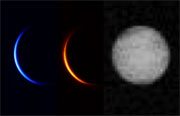  |
|---|
Dec. 8, 2010 Updated
AKATSUKI Venus orbit injection plan to be reviewed
|
JAXA found that we have failed to inject the Venus Climate Orbiter “AKATSUKI” into the planned Venus orbit after conducting the Venus orbit insertion maneuver (VOI-1) on December 7. While we set up a new investigation team to study the cause and countermeasures, we will also review the Venus orbit injection plan again to take the next opportunity in six years when the AKATSUKI flies closest to Venus. |
Dec. 8, 2010 Updated
AKATSUKI Venus observation orbit injection result
|
JAXA conducted the Venus orbit insertion maneuver (VOI-1) for the Venus Climate Orbiter “AKATSUKI” at 8:49 a.m. on December 7 (Japan Standard Time,) but, unfortunately, we have found that the orbiter was not injected into the planned orbit as a result of orbit estimation. The “AKATSUKI” was launched from the Tanegashima Space Center on May 21. |
Nov. 18, 2010 Updated
Date of AKATSUKI injection to Venus orbit
|
JAXA decided to emit jets from the orbital maneuvering engine (OME) of the AKATSUKI at 8:49:00 a.m. on Dec. 7 (Japan Standard Time, all the following dates and time are in JST) to inject the orbiter into the Venus orbit. Under the current schedule, the OME jet emission will be completed at 9:01:00 a.m. on the same day, and the Venus orbit will be determined around 9:00 p.m. also on the same day after some attitude control maneuvers including the Earth pointing maneuver of the Z axis. |
  |
|---|
Oct. 25, 2010 Updated
AKATSUKI takes images of Sagittarius using its onboard cameras
|
On October 8, the onboard cameras of the AKATSUKI took images of a part of Sagittarius. For this image shooting, we made the AKATSUKI face its cameras’ installed side to Sagittarius while the explorer was communicating with the Usuda Deep Space Center, and took images by activating the Longwave IR camera (IRC,) Ultraviolet Image (UVI,) 1µ m camera (IR1,) and 2µ m camera (IR2.) |
  |
|---|
Jul. 6, 2010 Updated
AKATSUKI successfully controls orbit by the world’s first ceramic thruster
|
On June 28 (Japan Standard Time,) the Venus Climate Orbiter “AKATSUKI” successfully jetted the thrust of 500 Newton by its orbital maneuvering engine (OME) at a distance of 14.6 million km from the Earth or 1.06 Astronomical Units (AU) from the sun. The OME was a newly developed ceramic thruster made of silicon nitride (Si3N4.) It is the first time in the world to successfully generate the thrust by the ceramic thruster in space. |
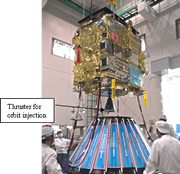  |
|---|
May 23, 2010 Updated
AKATSUKI flying smoothly!
|
On May 21, JAXA confirmed that the Venus Climate Orbiter “AKATSUKI,” We have also received earth images taken by the AKATSUKI while verifying the condition of onboard devices at about 250,000 km above the Earth at around 8:50 p.m. on May 21. |
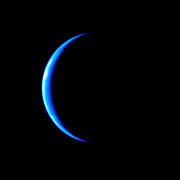  |
|---|
May 21, 2010 Updated
AKATSUKI successfully launched!!
|
The H-IIA Launch Vehicle No. 17 (H-IIA F17) with the Venus Climate Orbiter “AKATSUKI” onboard was launched at 6:58:22 a.m. on May 21 (Japan Standard Time) from the Tanegashima Space Center. The H-IIA F17 flew smoothly, and, at 27 minutes and 29 seconds after liftoff, the AKATSUKI was separated from the H-IIA. |
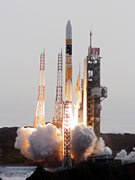  |
|---|
May 18, 2010 Updated
AKATSUKI/IKAROS Launch rescheduled to 6:58 a.m. on the 21st (Fri)
|
The launch of the Venus Climate Orbiter “AKATSUKI” and the Small Solar Power Demonstrator “IKAROS” by the H-IIA Launch Vehicle No. 17 was rescheduled at 6:58:22 a.m. on May 21 (Fri. Japan Standard Time, JST) after carefully studying the weather conditions. Accordingly, the live launch report will begin at 6:30 a.m. on May 21(Fri., JST.) The report will be broadcast not only through the Internet, but also at JAXA i, Sagamihara Campus and other public viewing locations including some universities. You can also watch it through some CATV and cell phone providers. |
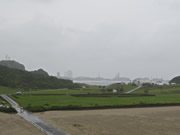  |
|---|
May 10, 2010 Updated
AKATSUKI and IKAROS moved to VAB
|
On May 9, the encapsulated Venus Climate Orbiter “AKATSUKI” and the Small Solar Power Sail Demonstrator “IKAROS” were transported to the Vehicle Assembly Building (VAB), where the H-IIA Launch Vehicle No. 17 was waiting for their payloads. They will be loaded onto the launch vehicle, and the final inspection will be carried out to be ready for the launch on the 18th. |
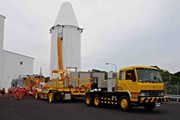  |
|---|
May 6, 2010 Updated
AKATSUKI encapsulated in the fairing
|
On May 4, the Venus Climate Orbiter “AKATSUKI” and the Small Solar Power Sail Demonstrator “IKAROS” were encapsulated in the fairing at the Spacecraft and Fairing Assembly Building (SFA) at the Tanegashima Space Center (TNSC.) The fairing covers the payloads to protect them from air resistance, friction heat, and acoustic vibrations during launch. The encapsulated payloads will be transported to the Vehicle Assembly Building and loaded on to the H-IIA Launch Vehicle No. 17. |
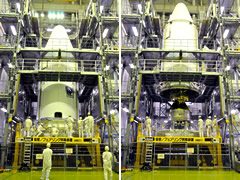  |
|---|
Apr. 30, 2010 Updated
AKATSUKI mated with the PAF
|
On April 30, the Venus Climate Orbiter “AKATSUKI” was mated with the Payload Attach Fitting (PAF,) which connects the AKATSUKI and the launch vehicle, at the Spacecraft and Fairing Assembly Building (SFA) at the Tanegashima Space Center (TNSC.) |
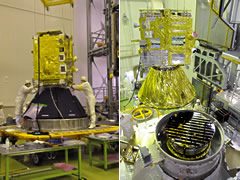  |
|---|
Mar. 19, 2010 Updated
AKATSUKI arrives at the Tanegashima Space Center
|
The Venus Climate Orbiter “AKATSUKI,” which left the Sagamihara Campus on March 17, arrived at the Spacecraft Test and Assembly Building 2 (STA2) in the Tanegashima Space Center at 5:30 p.m. on the 19th. |
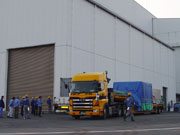  |
|---|
Mar. 18, 2010 Updated
AKATSUKI leaves for Tanegashima
|
The Venus Climate Orbiter “AKATSUKI” left the Sagamihara Campus for theTanegashima Space Center (TNSC) on the evening of March 17. |
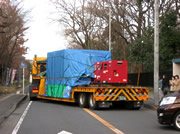  |
|---|
Mar. 12, 2010 Updated
AKATSUKI open to the media at Sagamihara Campus
|
On March 12, the Venus Climate Orbiter “AKATSUKI” and the Small Solar Power Sail Demonstrator “IKAROS” were displayed to the media at the Sagamihara Campus. |
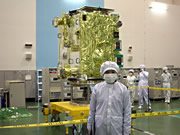  |
|---|
Mar. 3, 2010 Updated
“AKATSUKI” launch date set! Special site open
|
The launch time and day of the H-IIA Launch Vehicle No. 17 (H-IIA F17) has been set for 6:44:14 a.m. on May 18. The H-IIA will carry the Venus Climate Orbiter “AKATSUKI,” the Small Solar Power Sail Demonstrator “IKAROS,” and four other small satellites to space. |
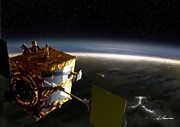  |
|---|
Feb. 10, 2010 Updated
Thank you very much for participating in the AKATSUKI message campaign
|
We have received many support messages from all over the world for the “AKATSUKI” message campaign, which was completed on January 10. The number of participants reached 260,214 people in total including those who registered through the Internet and those who signed up as a group from local areas, schools and science museums. We have also received messages from some celebrities. The messages will be printed on an aluminum plate, and attached to the body of the AKATSUKI. The satellite will then be transferred to the Tanegashima Space Center for launch preparations. |
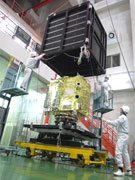  |
|---|
Dec. 17, 2009 Updated
AKATSUKI message campaign over New Year holidays!
|
JAXA is currently holding a message campaign to carry your name and message to Venus by placing them on the Venus Climate Orbiter “AKATSUKI.” |
  |
|---|
Nov. 30, 2009 Updated
AKATSUKI revealed to the public
Less than a month remains to send an onboard message
|
On Nov. 27, the Venus Climate Orbiter “AKATSUKI” was revealed to the press at the Flight Environment Test Building at the JAXA Sagamihara Campus. Comprehensive tests on the AKATSUKI will be continued further to be ready for its launch. |
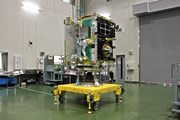  |
|---|
Oct. 23, 2009 Updated
We will deliver your message to the bright star Venus
|
The Venus Climate Orbiter “AKATSUKI” (PLANET-C,) which is scheduled to be launched in Japan Fiscal Year 2010, will reach the orbit of Venus about half a year after its launch. It is scheduled to explore the Venus atmosphere for some two years. JAXA will deliver your name and message to Venus on this Venus explorer. We accept messages both from individuals and from a group such as a message from a school or a work place. Please participate in the message campaign by yourself, with your family, or with your friends.We are looking forward to receiving your thoughts. We will accept your messages up to December 25. |
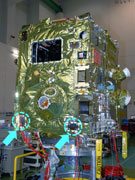  |
|---|
Jun. 1, 2009 Updated
Comprehensive tests start on PLANET-C
|
The PLANET-C project team started comprehensive tests in June. During testing, we first temporarily assemble all the parts to inspect the satellite comprehensively, disassemble it to check the components individually, then reassemble all the devices and components again to carry out various tests. Photo: A container carrying the satellite structure is being brought into the test facility. |
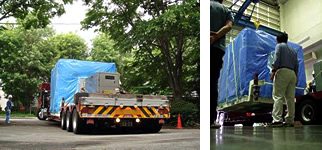  |
|---|
Jan. 6, 2009 Updated
Operations start for 2009
|
The satellite disassembly continues after the New Year holidays. The top photo show the removal of the 2μm infrared camera for observation (IR2) from the upper panel. Many pieces of equipment had been installed on the upper panel, but most of them were already removed. You can see the removed cameras on the table in the bottom photo. From the near side, they are the Ultra Violet Imager (UVI, a black camera under the blue plate), the 1μm Infrared Camera (IR1), the Longwave IR Camera (LIR, in a clear case) and the Lightening and Airflow Camera (LAC, wrapped in a golden sheet.) |
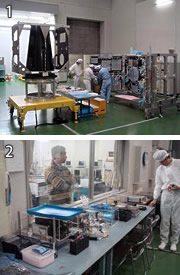  |
|---|
Dec. 26, 2008 Updated
Operations for 2008 completed
|
On Dec. 23, we tested the observation cameras by turning all five cameras on and sending actual observation commands to them to check if all the cameras worked properly. The top photo shows that the 1μm infrared camera was lit. In the photo, the structure with a white disk-shaped antenna at the top is the main body of the PLANET-C. As the solar array paddles were removed, the white round antenna that had been covered before was revealed. The cameras were attached at the right edge on the near side. There is a bright light instead of Venus in front of the cameras, thus a silhouette of the satellite is clear on the back wall. On December 25, various tests were completed, and the satellite was started to be disassembled. The bottom photo shows that the upper panel was carefully being removed from the satellite’s main body. |
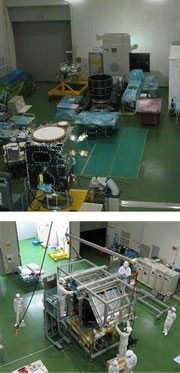  |
|---|
Dec. 18, 2008 Updated
First integration test underway
|
Since October 1, 2008, JAXA has been carrying out the first integration test for the PLANET-C. The test takes about three months to build up the satellite with most of the parts of the flight model into almost the launch configuration. The test is being held in the big clean room, and it is a very important test to verify mechanical and electric integration and function in the quasi launch configuration. It has been spectacular to witness all the individually developed parts and observation devices collected in one room to be set up as the satellite. |
  |
|---|
Jul. 9, 2008 Updated
Small secondary satellites to be launched with “PLANET-C” selected
|
On July 3, 2008, JAXA held the “Selection Committee Meeting for Small Secondary Payloads Launched with PLANET-C,” and the following four satellites were chosen as candidates for a piggyback launch with PLANET-C by H-IIA.
Among them, UNITEC-1 will be the world’s first satellite developed by a non-space organization to travel to Venus. |
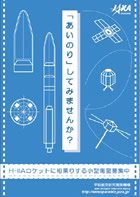  |
|---|
May 17, 2006 Updated
Developing a high-performance detector for seeing through the real surface of Venus
|
One of the five cameras aboard the Venus Climate Orbiter “PLANET-C” is the “IR2,” whose observation target is infrared rays that are about two micron in wavelength. It aims to measure the high-temperature atmosphere of Venus under thick clouds, its movement, and distribution of its trace components. In other words, the IR2 is a camera that can see through the real surface of Venus. The IR2 is made of materials suitable for infrared ray observations (manufactured by Nikon) and its photo-taking device (element) which is equivalent to a CCD in a digital camera is made of Platinum Silicide (PtSi) element (manufactured by Mitsubishi Electric.) The PtSi element is one million pixels (1024 x 1024). We are very proud of its high performance, which is far superior to commercially sold digital cameras or video cameras. It can work stably in the harsh environment of space with an excellent ability to capture both dark and bright objects (dynamic range) and a very high accuracy of measurement (linearity.) Currently, one million pixels is the highest level for this type of camera. The PtSi detector shown in the photo is a trial piece. The one million pixel (1024 x 1024) light receiving surface is about 17 mm x 17 mm in size and attached to the IC package. We have already acquired satisfactory results for this element through a cooling evaluation test. In May 2006, we began to manufacture the prototype and flight model elements by slightly modifying the design of the trial piece. The “IR2” and the other onboard infrared camera, “IR1,” are the main cameras of the orbiter. Although the two cameras target different observation wavelength ranges, their elements are almost the same. In addition to the lenses and elements, the camera unit itself, equipped with a cooling device for both the IR1 and the IR2, is developed by a Japanese precision equipment manufacturer (Sumitomo Heavy Industries, Ltd.) thus they are being developed 100% domestically. It is not easy for Japan to challenge the space development field by itself, as Japan lags behind Western countries. Still, we believe that we can accumulate knowledge through the challenge to sophisticate our own advanced technologies and promote our cutting-edge space science. Therefore both the engineers and scientists are working together for this development. |
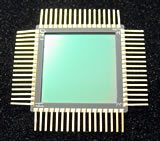  |
|---|
Aug. 29, 2005 Updated
Developing an infrared camera to explain mysteries of volcanoes and “super rotation of the atmosphere”
|
The Venus explorer, Planet C, was developed to observe the atmospheric movement of Venus by taking images of lights in various frequencies using five onboard cameras. By doing so, we try to elucidate the “super rotation of the atmosphere” that is the biggest mystery of meteorology in the solar system. Super rotation is a phenomenon where the atmosphere of Venus rotates about 60 times faster than Venus’ rotation. (The Venus rotation period is 243 days, whereas the atmosphere is 4 days.) The IR1 Camera, designed to capture infrared lights in one micron range wavelength, can carry out observations both day and night to contribute to the clarification of the mystery. During the day time, the IR1 will detect atmospheric movement in lower clouds, catching the deranged light of the Sun from the cloud layer (45 to 65 km) covering all of the surface of Venus. In the night, we plan to make it observe material compositions on the surface of Venus and look for an active volcano. It is well known that there are traces of volcanic activity on Venus, but no active volcano has been found yet. The observation team has high expectations of finding an active volcano, because, if we succeed, we can obtain clues to learn about the inside of Venus and its evolution. When we observe the night side of Venus, strong sunlight obstructs observation activities. Therefore, a sun shield cylinder plays an important role to protect our observation data by cutting off sunlight. The photo shows the testing of a new sun shield cylinder consisting of square and round shaped boards (in the big darkroom at the Usuda Deep Space Center in Nagano.) |
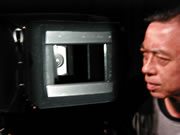  |
|---|
Apr. 13, 2005 Updated
Lightning and airglow camera (LAC) becomes drastically lighter
|
The Venus probe “PLANET-C” is equipped with five cameras, one of which is the first lightening and airglow camera (LAC) for a planet-probing mission in the world. The LAC can shoot 50,000 times per second using its high-speed mechanism to ensure it captures the precise moment when lightning strikes. (People think that we can see lightening flashes with our naked eyes, but it is actually through persistence of vision.) Outline of the Lightning and Airglow Camera (The latest version, Spring 2005) 1) LAC before design change (left) |
Oct. 20, 2004 Updated
Designing a prototype model of a probe
|
The Planet-C project, which was officially started this past April, is now at the stage of designing a prototype model of a probe. Planet C is equipped with five special onboard cameras for measuring infrared lights and ultraviolet rays in various wavelengths to observe from the surface to the upper atmosphere of Venus. For observation purposes, it is challenge to keep the inside temperature of the probe cool. Infrared lights are also known as “heat rays”, and a device may not be able to measure properly if it becomes too hot. Venus is 40 million kilometers closer to the Sun than the Earth. Therefore, the prerequisites to control the thermal environment for a Venus probe are far stricter than for a satellite cycling around the Earth. More specifically, the project faces challenges to design a more efficient method to release heat from the probe into space (thermal structure design) and to control the heat generated by onboard equipment. We need to adopt some parts that do not have any history of use in the space development area, thus we are carefully carrying out radiation exposure tests. The development team, consisting of research institutes and manufacturers across Japan, is working hard to achieve future applications for Earth observation missions. * Photo : The photo is a test image taken by a model device for evaluating the performance of one of the onboard cameras, the mid-infrared camera. The photographed subjects are two black boards whose temperatures are slightly different. The temperature difference is clearly shown in the photo. On the upper left side, you can see a camera called a “non-cooling bolometer” with a new detector that enables it to perform infrared measurements without being cooled down. Thanks to this new detector, the camera becomes much smaller than the conventional one that requires a system to cool a detector. We expect that the camera will elucidate the temperature and movement of clouds around Venus. |
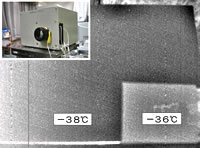  |
|---|
Feb. 27, 2004 Updated
JAXA to manufacture “trial model” of probe
|
The PLANET-C Project Team has been engaging in the initial design of the probe and development of a set of observation cameras for Venus. Many of the cameras are embedded with high pixel infrared sensors. Therefore, many tests, including radiation exposure, were carried out to verify their reliability in a space environment and to maximize their performance. * Photo : Infrared cameras under development. Universities and research institutes, including Hokkaido University, Tohoku University, National Institute of Polar Research, Tokyo University, Osaka Prefecture University, and Kumamoto University, participate in the development of scientific observation equipment such as a set of infrared cameras. |
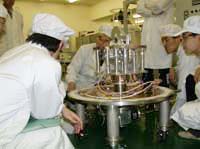  |
|---|
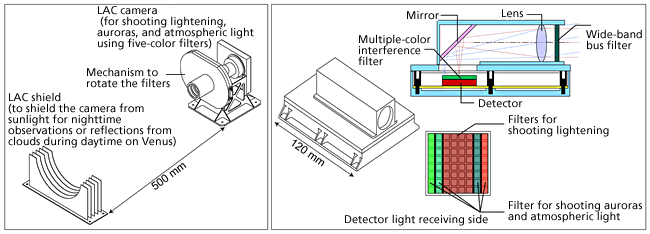
Comments are closed.